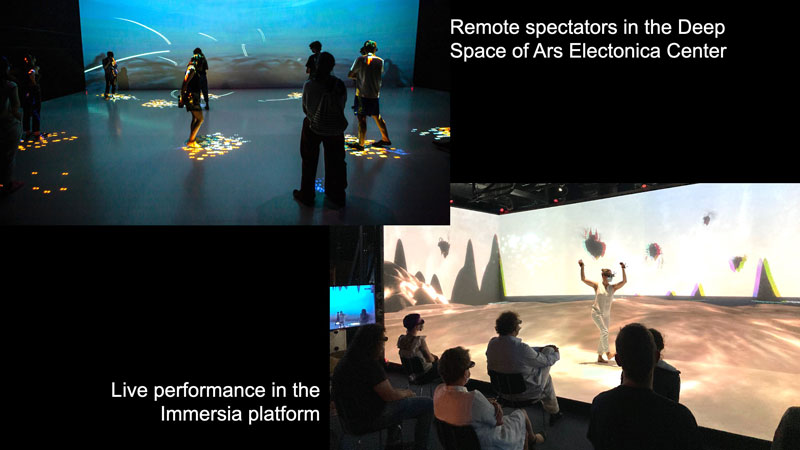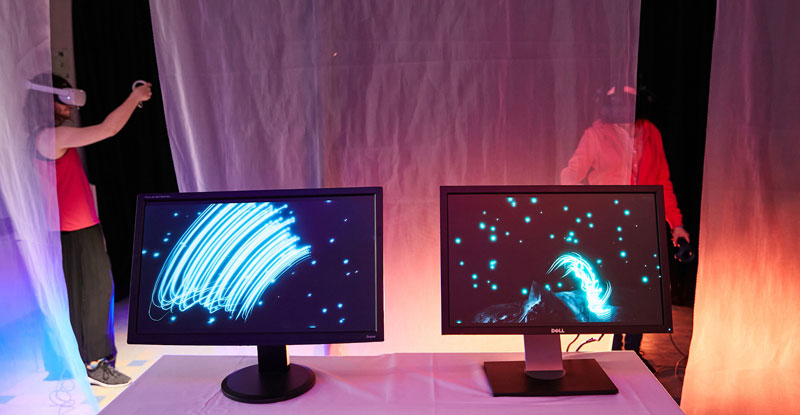by Julien Lomet (Univ Paris 8, Univ Rennes 2, IRISA), Ronan Gaugne (Univ Rennes, Inria, CNRS, IRISA) and Valérie Gouranton (Univ Rennes, INSA Rennes, Inria, CNRS, IRISA)
Collaborative virtual spaces allow to establish rich relations between involved actors in an artistic perspective. Our work contributes to the design and study of artistic collaborative virtual environments through the presentation of immersive and interactive digital artwork installation, named “Creative Harmony”. In this project, we explore different levels of collaborations proposed by the “Creative Harmony” environment, and we question the experience and interactivity of several actors immersed in this environment, through different technological implementations.
The collaborative artwork “Creative Harmony” (“CH”) [1][L1] was designed within a multidisciplinary team of artists, researchers and computer scientists from different laboratories. The “CH” experience is based on a live performance that involves a dancer and a musician who are performing in front of an immersed public, and collaborative spectators who are remotely engaged to the experience through full-body movements (Figure 1). The performance is structured around three phases, one introductive meditative phase to be immersed in the universe of “CH”, one active phase of co-creation of a shared landscape whose aesthetic is inspired by the German Romantism painting from 19th century (Figure 2), and a last phase of contemplation of the co-created landscape. In order to foster co-presence, each participant of the experience is associated to an avatar that aims to represent both its body and movements, but in an artistic semi-humanoid appearance. The music is an original composition designed to develop a peaceful and meditative ambiance to the universe of “CH”.

Figure 1: Overview of the “Creative Harmony” principle.

Figure 2: The co-creation scene in the “Creative Harmony” experience.
One originality of the “CH” experience is the exploration of the relaxation of the spectators. We propose to explore this complex state of emotion through the analysis of the “CH” experience. A first user study was conducted to measure the impact on mood resulting from immersion and interactivity, taking into account the collaboration, the curiosity of creation, the involvement of the spectator in the interactive process and the contemplation of the resulting virtual environment. We evaluated the impact of the artistic virtual experience on users’ emotional state before and after their performance in virtual reality. We proposed a method based on a cognitive approach to evaluate this impact, with a standard tool widely used in psychological studies, the BMIS scale. The study of these results highlighted a significant impact on the emotional state of the participants with increase of positive mood indicators and decrease of negative ones, with the highest evolution for tiredness, nervousness, calmness and happiness [2].
The “CH” experience was exhibited in several artistic and scientific events with adapted technological environments. The underlying VR application was developed in order to ease its deployment in various configurations. The first public exhibition was performed at the international festivals Ars Electronica festival in Linz in 2020 (Figure 3), with a remote collaboration between the Ars Electronica Deep Space facility [L2] and the Immersia research platform [L3], in Rennes, France. For this exhibition, the dancers and the musician were performing in Rennes, in front of a passive audience equipped with stereoscopic shuttles to visualise the 3D content displayed in Immersia. The remote audience in Ars Electronica was immersed in the virtual environment in the Deep Space, interacting with feet positions in the space tracked at ground level with a lidar system. The co-created content was synchronised in real-time between the two sites using a network library in Unity.

Figure 3: The distant exhibition of “Creative Harmony” between Ars Electronica Center and the Immersia platform.
In a second exhibition, for a music and science public event, the performance part was the same than in the Ars Electronica while remote interactive participants were connected using HMDs in a remote building of the same city. The users connected with HTC Vive HMDs were interacting through hand movements, tracked via controllers’ positions. This particular configuration was the one used for the user study in [2]. The “CH” experience was also presented in the international Digital Arts and Electronic Music festival LEV in Spain, in 2021 and international Digital Arts festival Recto VRso in France in 2022 (Figure 4). In both cases, we used the same configuration, with two spectators collaborating in the virtual environment connected with Oculus Quest 2. In this configuration, no live performance was associated to the experience. One of the two users was playing the role of the dancer, while the other was playing the former role of connected and interacting spectator. Other public exhibitions of the artistic creation “CH” in various public events implemented either the Immersia-HMDs or HMD-HMD version of the environment, using the same core Unity application.

Figure 4: “Creative Harmony” for two spectators in the Recto VRso festival.
Current research and developments of the “CH” environment are considering and investigating three main directions:
1. New modalities to foster the collaborative engagement. The user study presented in [2] showed a lack of understanding of the co-creation part of the experience. We have integrated new physiological modalities to interact and collaborate in order to enhance co-creation comprehension and engagement. We have also rebalanced the sense of creative freedom for both roles. A user study is currently conducted to assess this aspect.
2. New applications of the experience. Beyond the artistic creation, we want to explore the possibility to benefit from both the relaxing effect and the full-body engagement, particularly through breath interaction and interactive collaboration design. The impact on the well-being of the users is under investigation within a new multi-disciplinary research project.
3. New technological configurations. We investigate in particular a Cave-to-Cave version in order to explore distant collaborative artistic creation and live performance. We benefit for this aspect from the support of the Continuum French infrastructure network.
This work was supported by the IRISA research axis “Art, culture and heritage” grant CNRS and by French PIA grant ANR-21- ESRE-0030 (CONTINUUM).
Links:
[L1] https://www.julienlomet.com/creative-harmony
[L2] https://ars.electronica.art/center/de/deepspace/
[L3] https://www.irisa.fr/immersia/
References:
[1] J. Lomet, et al., “Collaboration in a virtual reality artwork: the experience of co-presence, co-creation and letting go,” in MOCO 2022-8th International Conference on Movement and Computing, 2022.
[2] J. Lomet, R. Gaugne, V. Gouranton, “Could you relax in an artistic co-creative virtual reality experience?,” in ICAT-EGVE, joint Int. Conf. of the the 32nd Int. Conf. on Artificial Reality and Telexistence & the 27th Eurographics Symposium on Virtual Environments, pp. 1–9, 2022.
Please contact:
Ronan Gaugne, Univ Rennes, Inria, CNRS, Irisa, France










